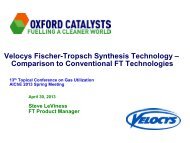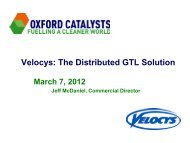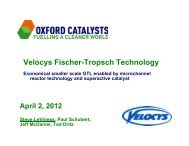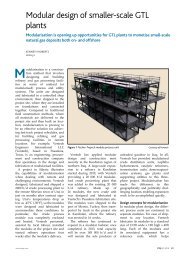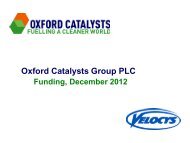Improved Fischer-Tropsch Economics Enabled by Microchannel ...
Improved Fischer-Tropsch Economics Enabled by Microchannel ...
Improved Fischer-Tropsch Economics Enabled by Microchannel ...
You also want an ePaper? Increase the reach of your titles
YUMPU automatically turns print PDFs into web optimized ePapers that Google loves.
In the absence of contaminants, there are two types of<br />
catalyst deactivation in FT synthesis: 1) short-term<br />
deactivation caused <strong>by</strong> wax build-up and/or partial oxidation<br />
of the cobalt catalyst particles, and 2) longer term<br />
deactivation, which involves sintering, loss of pore structure<br />
and/or build-up of refractory carbon. The first is reversible;<br />
the second may be reversible under certain conditions, but<br />
could require replacing the catalyst. For short-term<br />
deactivation, in situ hydrotreating was shown to be effective<br />
at restoring catalyst activity. Figure 7 displays reactor<br />
performance data at the same conditions before and after<br />
regeneration.<br />
Conversion, Selectivity (%)<br />
100%<br />
90%<br />
80%<br />
70%<br />
60%<br />
50%<br />
40%<br />
30%<br />
20%<br />
Regeneration<br />
CO Conversion<br />
CH4 Selectivity<br />
Temperature<br />
370<br />
350<br />
330<br />
310<br />
290<br />
270<br />
250<br />
230<br />
210<br />
Temperature (°C)<br />
segregated <strong>by</strong> sequential condensation. In Shell’s fixed bed<br />
design, catalyst is packed into small tubes inside a large<br />
diameter vessel with means to remove heat <strong>by</strong> boiling water<br />
around the tubes. To maintain a reasonable pressure drop,<br />
catalyst particles in conventional fixed bed reactors are<br />
relatively large, in the range of 1 mm. This often limits the<br />
rate of reaction and leads to higher than desired selectively<br />
to methane.[7]<br />
<strong>Microchannel</strong> FT reactor technology provides<br />
substantial techno-economic benefits over conventional<br />
fixed bed technology, including:<br />
1) <strong>Microchannel</strong> FT has thin reaction channels, 1 to<br />
2 orders of magnitude smaller characteristic dimensions in<br />
competing fixed bed designs. This attribute greatly<br />
improves heat and mass transfer, allowing optimal<br />
temperature control across the catalyst bed, and leads to far<br />
higher reactor productivity. Figure 8 shows reactor<br />
productivity, defined as barrels/day of FT product per ton of<br />
reactor mass compared to large-scale FT reactor systems.<br />
Both Shell data points are fixed bed designs, while Sasol<br />
Oryx uses slurry bed reactors.<br />
10%<br />
190<br />
12<br />
0%<br />
0 500 1000<br />
170<br />
2000 2500<br />
Time on Stream (hr)<br />
Figure 7. <strong>Microchannel</strong> FT in-situ regeneration shown effective at<br />
recovering performance<br />
Catalyst Integration. Placing catalyst in packed bed<br />
reactors can be a challenge for any technology.<br />
Conventional FT reactors have as many as 29,000 small (1”)<br />
diameter tubes 12m in length, which must be equally loaded<br />
and then unloaded after 2 to 5 years of operation.[6] These<br />
high aspect ratio (over 500:1 length to diameter) tubes are<br />
hung in very large, immobile reactors, but commercial<br />
integration techniques have been shown effective for<br />
loading and unloading the catalyst. Because microchannel<br />
technology has extremely small passages, many expect<br />
catalyst loading and unloading to be especially challenging,<br />
but this was found not to be the case.<br />
Catalyst loading, regeneration and unloading for<br />
microchannel FT reactors have been successfully<br />
demonstrated. Multiple operating and non-operating<br />
reactors with commercial length microchannels (aspect ratio<br />
385:1 length to hydraulic diameter) have been repeatedly<br />
loaded and unloaded. A mechanical loading method is<br />
employed using commercially available material handling<br />
techniques and equipment.<br />
Comparison with Competing FT Technologies<br />
Due to improved volumetric and catalytic productivity,<br />
microchannel FT enables lower capital and operating costs<br />
compared to conventional FT reactor systems, including<br />
tubular, fixed-bed with cobalt catalyst, and slurry-bubble<br />
with cobalt or iron catalyst.<br />
Fixed Bed. In a conventional (tubular) fixed bed designs, all<br />
reaction products exit through a single outlet, leaving the<br />
catalyst behind in the reactor. The resulting products are<br />
0<br />
0 2,000 4,000 6,000 8,000 10,000 12,000<br />
Scale of Single Reactor (bpd)<br />
Velocys © 2011 Page 4 of 7<br />
Reactor Productivity (bpd/tonne)<br />
10<br />
8<br />
6<br />
4<br />
2<br />
300 bpd <strong>Microchannel</strong><br />
Reactor Assembly<br />
Shell - Bintulu<br />
Shell - Pearl<br />
Sasol - Oryx<br />
Figure 8. <strong>Microchannel</strong> FT improves reactor productivity and<br />
achieves economy of scale at far lower capacity<br />
<strong>Microchannel</strong> FT also achieves approximately 10 times<br />
higher catalyst productivity, defined as kg/hr of synthesis<br />
gas processed per cubic meter of catalyst volume. Both<br />
capital and operating costs are thus reduced.<br />
2) The basic building blocks of the microchannel FT<br />
reactor systems are components with thousands of parallel<br />
microchannels. These reactor components, which have fixed<br />
production capabilities, can be added or removed to match<br />
throughput requirements. When this modular design<br />
approach is combined with process intensification benefits<br />
discussed above, two advantages are realized:<br />
a. <strong>Microchannel</strong> FT realizes economies of scale at<br />
much smaller size (500 bpd) than conventional technology<br />
(10,000 bpd). This advantage allows microchannel FT to be<br />
feasible for BTL applications since it is not practical to<br />
transport the required biomass feedstock of 10,000 tons/day<br />
for a 10,000 bpd facility. The smaller economy of scale also<br />
permits feasibility for distributed and offshore GTL.



